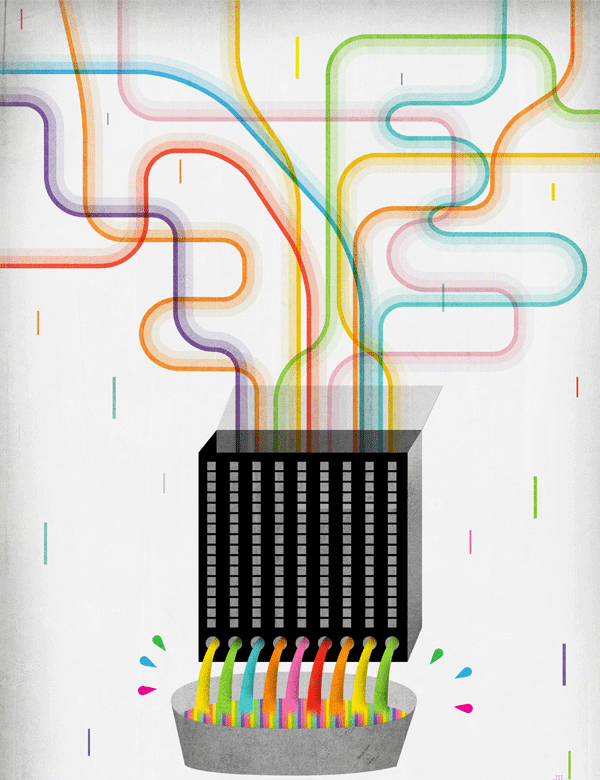Mass communication happens when information is being shared to the public through media. After almost two centuries, the mass communication and mass media landscape widely shifted and changed how information moved across the world. Platforms, styles, devices, and methods in mass communication had their trends in different times due to the speedy evolution of technology and the changing demand of the receivers of information, the audience.
From Mass Media Organizations to Mass Media Businesses

Several industrial and economic factors contributed to the evolution of mass media. Critics say that this evolution also shifted mass media’s purpose; from being public-service oriented to profit driven.
One factor that made a mark in the mass media history is the concentration of ownership and conglomeration. From the 1830s to the present, the ownership of mass media companies concentrated into fewer and fewer names. From being independent media organizations, these organizations are now owned by big business tycoons. The discovery of new technology and its utilization in mass communication can be credited to the business industry’s machinery. The businesses’ financial capability may explain why print, radio, television and digital media came along in a short span of time. However, the change of ownership also resulted to a conflict of interest. Mass media shifted from journalism to entertainment. Since businessmen controlled the mass media, by nature, their focus was on making money. So, what they wanted was an entertained rather than an informed public. Because of this, hypercommercialism also existed in mass media. Newspapers, radio programs, tv programs and even the internet are now filled with advertisements. Product placement or the integration for a fee of specific branded products into media content, also came along.
The transition from print to audio-visual media is also brought by globalization and the changing demand of the audition. Since the reach and range of traditional media was very limited, resulting to a lower profit, mass media companies used new technology in the aim for globalization. However the broadcast of a certain program to the whole world, resulted to a certain disrespect to local values, culture, tradition and customs. This resulted to a division of opinion and made the audiences “selective” on content. The division of opinion also created a variety of interests and demands to different audiences and this gave birth to audience fragmentation and narrow casting. Media companies produce certain programs exclusive for specific audiences to feed their demand and assure profit.
The Digitization of Video

In the 90’s the analog visual media transformed to digital, making it more cost-efficient, accessible, and refined. The digital video disc’s (DVD) arrival in 1996 , enabled the audience to pause the videos without losing its quality, subtitle a movie in various languages, and can access relevant information related to the content- in its portable form. In 1999, the digital video recorder (DVR) came along, the viewers can now rewind and playback the content while recording it, for its preservation. For the producers, the arrival of DVD and DVR made reproduction of content more profitable. The additional features in DVD created a higher demand for the content and the DVR being an addition to broadcast programs also has a monthly price for its subscription.
Television also became digitized, and it allowed the viewers to enjoy high definition and high quality content in a variety of genres, straight to their homes. According to Baran (2013), “the traditional television broadcasters see digitization of television signals as their salvation”. Because digitized TV allowed them to air multiple forms of content in a single signal. It also gave the producers an option to multiplex (divide their channels, and separate HD to non-HD) to produce more profit.
The digitization of video, made mass media richer and increased the quality of its content.
Media accessibility: A double edged sword

Industrialization, innovation and digitization of mass media made information within the reach of the masses. Because of the current discoveries in technology, geographical distance isn’t already a problem. Public education also become easier and more cost efficient, media accessibility provides appropriate content that can aid in the effectiveness of instruction and the efficiency of the learning process. Media accessibility is also good for content producers, especially those who aim for patronage, fame and profit. With the technology today, in just one click your content can go viral and you can earn money in seconds. However, the wider reach of mass media isn’t purely beneficial, it also has negative implications to the mass media environment. According to Baran (2013), “the distinction between content consumer and content provider disappears”. With media accessibility, content consumers become content producers. Today, anyone can produce content with minimal restrictions. This is good for freedom of speech, but as some say, too much freedom isn’t good. The rise of bloggers and other unregulated and unchecked content producers sparked the triumph of misinformation and disinformation. Many people use media accessibility to spread false and information. The media accessibility today, degrades mass communication, media and journalism as a profession. Media and its accessibility today also contributes to the decline of the occurrence of human communication, especially face to face communication. With the media like social media being the trend today, real life human interactions gradually decreased. This somehow further divided our world and created a culture of anger, especially in social media.
Mass communication and mass media went through numerous changes throughout history. There’s nothing wrong with that, as long as it changes, for the improvement of communication, development of information and the betterment of the society. The changes in mass comm and mass media should always stay true to its purpose- to guide the public in making informed decisions and bridging the gaps in between them.
Sources:
Baran, S. J. (2013). “Chapter Two: The Evolving Mass Communication Process” in Introduction to mass communication: media literacy and
culture. New York, NY: McGraw-Hill.
Baran, S. J. (2013). “Chapter Eight: Television, Cable, and Mobile Video” in Introduction to mass communication: media literacy and
culture. New York, NY: McGraw-Hill.
